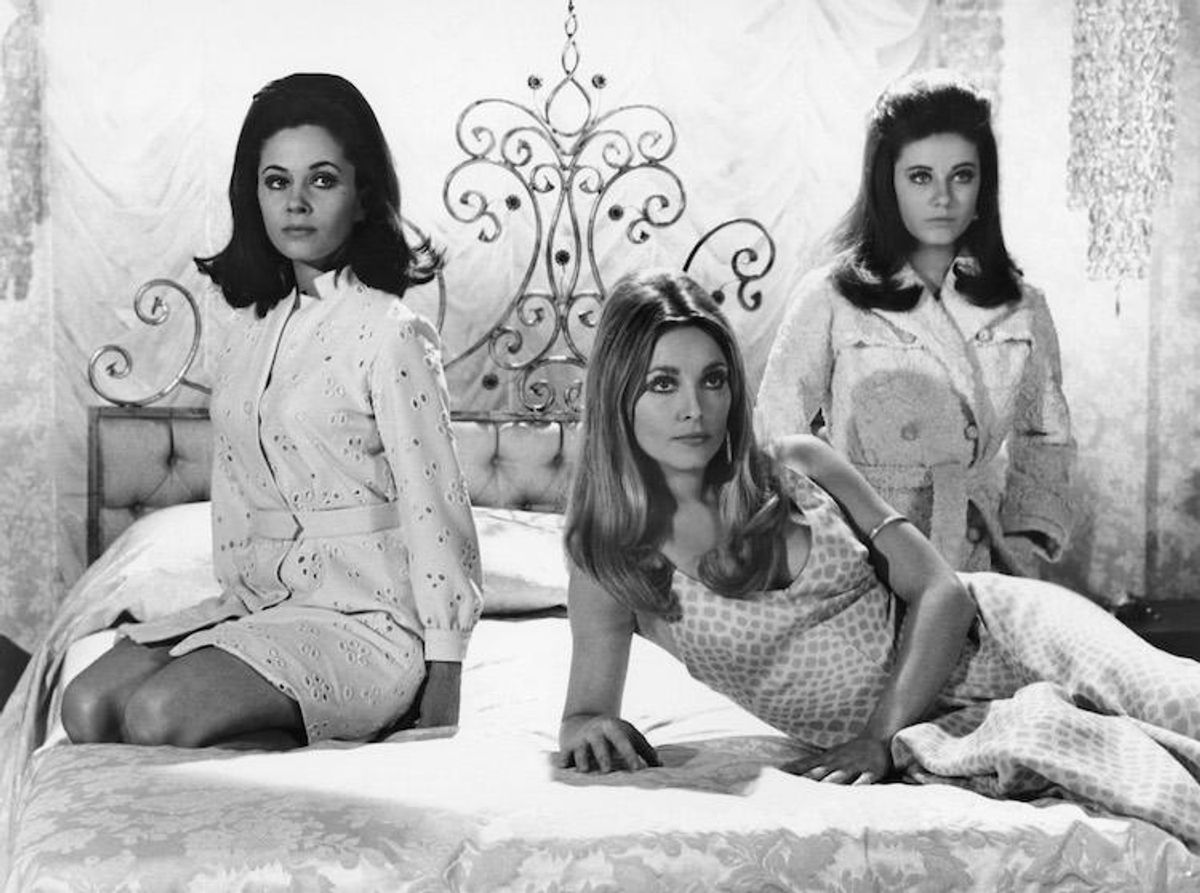This month marks the 50th anniversary of Jacqueline Susann's sensational best seller The Valley of the Dolls, the one about the trio of girls entering the dreamland of show biz, only to fall through the trap door of drugs, booze, and screwed-up men. The book--by the savvily self-promoting Susann--is a crackling read, but I'm even more obsessed with the glossy movie version that came out a year later, the one that's become required viewing for anyone angling for a gay card. Susann reportedly wanted to throw herself overboard when she saw the movie at its premiere on a cruiseship--I guess she thought it was too trashy, even for her--but it gives me life, enthralling me with its campy dialogue, over-the-top performances, and fabulous fashion.
While the book was set in the 1940s, the film brought things up to the present (the 1960s), complete with lots of big hair and shiny outfits. (Sharon Tate's metallic dress with matching coat is a Travilla classic, and so are her sexy palazzo pants by the pool.) Neely O'Hara, the up-and-coming singer played by Patty Duke, is based on pill popping Judy Garland, and Susann had interestingly wanted Judy's daughter Liza Minnelli for the role. Meanwhile, Neely's nemesis is aging barracuda Helen Lawson--based on Ethel Merman--who Judy Garland was set to play until she became too Neely-ish and got axed, garnering another part for Susan Hayward. So it would have been Liza as Judy battling it out with Judy as Ethel Merman--it boggles the mind! And did I mention that Merman was rumored to have been Susann's old girlfriend?
So many other things about this film set your head spinning in a good way, as I've noticed it from watching it 3000 times. For example:
*THE NECKLACE
While Patty Duke is singing the improbable "It's Impossible," it gets caught hanging around her left boob and just won't budge. It may be the only spontaneous moment in the whole film.
*THE UNEARNED PATHOS OF THE REHAB SCENE
Tony Polar is in a wheelchair, having been diagnosed with a mysterious terminal illness. Neely's in the same rehab center, dealing with her drug problem. I guess they just throw everyone with any kind of health issue together into one big room. They spot each other and start singing "Come Live with Me" as a sickening duet. The moment would break your heart, except that they barely shared any screen time before that--and most recently, Neely had been running from him, fearing he'd ask for work.
*THE MOBILE
When Helen Lawson is singing "I'll Plant My Own Tree"--another of Dory and Andre Previn's rivetingly weird songs from the film--she's dodging a gigantic mobile that's threatening to rip her wig off, much like Neely does later on. The sung has rotten lyrics like "It's my yard/So I will try hard/To welcome friends I have yet to know." It's allegedly part of some kind of Broadway smash called Hit The Sky, obviously a show about trees and mobiles. And the whole time, Barbara Parkins and Paul Burke sit in the audience, carrying on about how magical Helen is onstage. This even though she is dubbed by Margaret Whiting, moves her arms like some kind of drag queen robot, and keeps her mouth open long after the last note is finished.
*THE BATHROOM SCENE
Neely's showdown with Helen is a historic (and hysterics') campfest, filled with snappy zingers and wig flushing. "It was not a nuthouse!" Neely shrieks, as poor Helen has to wrap a kerchief around her head and go out the way she came in. She needn't be ashamed, as she got in the movie's best monologue. ("They drummed you out of Hollywood, so you come crawling back to Broadway...") Priceless shit.
*LEE GRANT
She plays Tony Polar's caring half-sister/manager sister Miriam, and seems to be doing her own movie, clearly convinced she's in something by Chekhov. Always smoldering and worrying, Grant's Miriam puts a lot of emphasis on things like heating up the lasagna, also offering weird fortune cookie tidbits like "At night, all cats are gray" and "Some men just don't pull well in double harness." In her memoir, Grant said that Sharon Tate was the only one she believed in the whole movie--including herself.
*THE GAY STUFF
It's all incredibly incorrect, but it mirrors the phobias of that era--and besides, it's so long ago (and campy) that we can sit back and laugh about it today. Furthermore, Sharon Tate comes off so sweet when she purrs "You know how bitchy fags can be" that she makes the "f" word sound better than it is. The truly nutty scene, though, is Neely declaring about her new amour, "Ted Casablanca's not a fag--and I'm the dame that can prove it." When she catches Ted cheating--with a girl--he reminds her that at least it's not a boy, to which she replies, "I could take that better." So could I--I wish they'd had the courage of their lack of convictions and at least shown Ted being bi. Oh, well. Either way, it drives Neely to more "dolls" and more self destruction. ("I'm Neely O'Hara!!!!")
ALSO, THE OPENING CREDITS
And the montages. And Parkins' gorgeous Gillian commercial. And the guest stars (like George Jessel and Joey Bishop). The future stars (like Richard Dreyfuss). The lines ("Boobies, boobies, boobies. Who needs 'em?"; "That little whore makes me feel nine feet tall!"). Jackie Susann's Hitchcock-like cameo. And the screenplay's sly commentary on sexism. The only bad thing, in fact, is that the men are extremely wooden, and Burke's scenes with Parkins particularly threaten to nullify all the fun. But then it gets fab again. Happy anniversary, Valley. You're a doll!
BILL CUNNINGHAM WAS MARRIED TO HIS WORK

Photo courtesy of AP/Mark Lennihan
Moving on to the valley of the fashionistas, Bill Cunningham was the New York Times photographer who captured NYC's best street and event style for many years. Sending a jolt through the glitterati, Cunningham recently died at 87 after a stroke, leading to an array of big names wearing designer clothes to his funeral. One of his most frequent subjects, the nattily attired Patrick McDonald, told me, "I owe everything to Bill, as far as people knowing who I am in fashion, because Bill always took a chance and went out on a limb for someone that was different. He lived his life the way he wanted to. He didn't want money. He was the sweetest, most sincere, honest man I've ever met."
Did Bill ever talk to him about his love life? "No," McDonald said. "The loves of his life were the streets of New York, and he was inspired every time he saw someone he was fond of. He devoted his life to that. We never talked about his personal life. He was a religious man and went to church and grew up at a time when...he didn't hide it, but it wasn't something you discussed."
AUSTEN'S POWERS

Photo courtesy of Bedlam Theater
Well, classics you read back in school are not only discussed, they're demystified and aggressively reinvented on a regular basis. Famed stories which have been de-starched and sassed up via fourth wall breaking, anachronisms, and shtick have come at us, with varying results, thanks to post-modern productions of The 39 Steps, Brief Encounter, and Peter and the Starcatcher. And the trend continues with the Bedlam Theater's returned production of Sense & Sensibility, which is definitely not your granny's Jane Austen. The show--done in a theater-in-the-rectangle type of setting, at the Gym at Judson--starts with the actors getting made up within view, then coming onstage to do a line dance in modern clothing, gradually changing into period dress for the tale of dalliances, hookups, marriage and, mainly, gossip. The actors push and pull set pieces on and offstage and sometimes indulge in comic bits that, for me, were often too arch and angling for a laugh. Considering all the effort spent to breathe new life into a golden oldie, the show seems stronger when it just sticks to the story. But Act Two felt more vigorously cohesive, and the play--adapted for the stage by Kate Hamill and directed by Eric Tucker--is energetic and persuasively underscores the buffoonery of people attempting good manners. And in having five sisters looking for mates and stability, it even one-ups Valley of the Dolls!



























































































